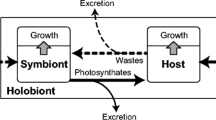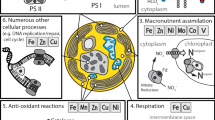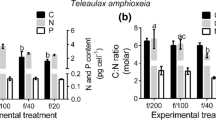Abstract
Nutrient sufficiency of zooxanthellae in the sea anemone Aiptasia pallida cultured in low nutrient seawater depends on the availability of particulate food to the host. Zooxanthellae in anemones unfed for 20 to 30 d exhibited the following characteristics of nutrient deficiency: cell division rates decreased; chlorophyll a content gradually decreased from 2 to <1 pg cell−1; and C:N ratios increased from 7.5 to 16. Over a 3-mo period, algal populations in unfed anemones gradually decreased, indicating that zooxanthellae were lost faster than they were replaced by division. The mitotic index of zooxanthellae in unfed anemones was stimulated either by feeding the host or by the addition of inorganic N and P to the medium. Whether algae are nutrient-limited in hosts under field conditions has not been examined fully; however, C:N ratios in zooxanthellae from field-collected hosts are slightly higher (9.4 vs 7.5) than in hosts fed to repletion in laboratory cultures. This observation might indicate N limitation in the field.
Similar content being viewed by others
Literature cited
Blank, R. J., Trench, R. K. (1986). Nomenclature of endosymbiotic dinoflagellates. Taxon 35: 286–294
Bradford, M. M. (1976). A rapid and sensitive method for the quantitation of microgram quantities protein utilizing the principle of protein-dye binding. Anal. Biochem. 72: 248–254
Burris, R. E. (1983). Uptake and assimilation of 15NH4 + by a variety of corals. Mar. Biol. 75: 151–155
Cates, N., McLaughlin, J. J. A. (1979). Nutrient availability for zooxanthellae derived from physiological activities of Condylactus spp. J. exp. mar. Biol. Ecol. 37: 31–41
Chalker, B. E., Dunlap, W. C., Oliver, J. K. (1983). Bathymetric adaptations of reef-building corals at Davies Reef, Australia. II. Light saturation curves for photosynthesis and respiration. J. exp. mar. Biol. Ecol. 73: 37–56
Chang, S. S., Prézelin, B. B., Trench, R. K. (1983). Mechanisms of photoadaptation in three strains of the symbiotic dinoflagellate Symbiodinium microadriaticum. Mar. Biol. 76: 219–229
Clayton, W. S. (1985). Pedal lacertion by the anemone Aiptasia pallida. Mar. Ecol. Prog. Ser. 21: 75–80
Clayton, W. S., Lasken, H. R. (1984). Host feeding regime and zooxanthellal photosynthesis in the anemone, Aiptasia pallida (Verrill). Biol. Bull. mar. biol. Lab. Woods Hole 167: 590–600
Cook, C. B. (1971). Transfer of 35S-labelled material from Aiptasia sp. to its endosymbiotic zooxanthellae. In: Lenhoff, H. M. et al. (eds.) Experimental Coelenterate Biology, University of Hawaii Press, Honolulu, p. 218–224
Cock, C. B. (1972). Benefit to symbiotic zoochlorellae from feeding by green hydra. Biol. Bull. mar. biol. Lab., Woods Hole 142: 236–342
Cook, C. B., D'Elia, C. F. (1987). Are natural populations of zooxanthellae ever nutrient-limited? Symbiosis 4: 199–212
D'Elia, C. F. (1977). The uptake and release of dissolved phosphorus by reef corals. Limnol. Oceanogr. 22: 301–315
D'Elia, C. F. (in press 1987 a). Biogeochemical nutrient cycles in coral reef ecosystems. In: Dubinsky, Z. (ed.) Coral Reef Ecosystems: Ecosystems of the World Series. Elsevier Science Publishers, Amsterdam
D'Elia, C. F. (in press 1987 b). The cycling of elements in coral reefs. In: Alberts, J. J., Pomeroy, L. R. (eds.) A conference on ecosystem processes in honor of E. P. Odum. University of Georgia. Springer-Verlag, Heidelberg
D'Elia, C. F., Webb, K. L. (1977). The dissolved nitrogen flux of reef corals. Proc. 3rd int. Coral Reef Symp., Vol I, University of Miami, Miami, p. 325–331
Dawes, C. J., Chen, C.-P., Jewett-Smith, J., Marsh, A., Watts, S. A. (1984). Effect of phosphate and ammonium levels on photosynthetic and respiratory responses of the red alga Gracilaria verrucosa. Mar. Biol. 78: 325–328
Domotor, S. L., D'Elia, C. F. (1984). Nutrient uptake kinetics and growth of zooxanthellae maintained in laboratory culture. Mar. Biol. 80: 93–101
Falkowski, P. G., Dubinsky, Z. (1981). Light-shade adaptation of Stylophora pistillata, a hermatypic coral from the Gulf of Eilat. Nature, Lond. 289: 172–174
Fitt, W. K., Chang, S. S., Trench, R. K. (1981). Motility patterns of different strains of the symbiotic dinoflagellate Symbiodinium (=Gymnodinium) microadriaticum (Freudenthal) in culture. Bull mar. Sci. 31: 436–433
Goldman, J. R., McCarthy, J. J., Peavey, D. G. (1979). Growth rate influence on the chemical composition of phytoplankton in oceanic waters. Nature, Lond 279: 210–215
Gordon, D. M., Birch, P. B., McComb, A. J. (1981). Effects of inorganic phosphorus and nitrogen on the growth of an estuarine Cladophora in culture. Bot. Mat. 24: 93–106
Graneli, E., Sundback, K. (1985). The response of planktonic and microbenthic algal assemblages to nutrient enrichment in shallow coastal waters, southwest Sweden. J. exp. mar. Biol. Ecol. 85: 253–268
Hoegh-Gulderg, O., Hinde, R., Miscatine, L. (1986). Studies on a nudibranch that contains zooxanthellae II. Contribution of zooxanthellae to animal respiration (CZAR) in Pteraeolidia ianthina with high and low densities of zooxanthellae. Proc. R. Soc. London, Ser. B 228: 511–521
Hunter, T. (1984). The energetics of asexual reproduction: pedal laceration in the symbiotic sea anemone Aiptasia pulchella (Carlgren 1943). J. exp. mar. Biol. Ecol. 83: 127–147
Jeffrey, S. W., Haxo, F. T. (1968). Photosynthetic pigments of symbiotic dinoflagellates (zooxanthellae) from corals and clams. Biol. Bull. biol. Lab., Woods Hole 135: 145–165
Lowry, O. H., Rosenbrough, N. J., Farr, A. L., Randall, R. (1951). Protein measurement with the Folin phenol reagent. J. Biol. Chem. 193: 265–276
McAuley, P. J. (1986). Isolation of viable uncontamined Chlorella from green hydra. Limnol. Oceanogr. 31: 222–224
McDuff, R. E., Chisholm, S. W. (1982). The calculation of in situ growth rates of phytoplankton populations from fractions of cells undergoing mitosis: a clarification. Limnol. Oceanogr. 27: 783–788
Menzel, D. W., Ryther, J. H. (1961). Annual variation in primary production of the Sargasso Sea off Bermuda. Deep-Sea Res 7: 282–288
Meyer, J. L., Schultz, E. T. (1985). Tissue condition and growth rate of corals associated with schooling fish. Limnol. Oceanogr. 30: 157–166
Morris, B., Barnes, J., Brown, F., Markham, J. (1977). The Bermuda Marine Environment. Volume I, Bermuda Biological Station for Research, Inc. Special Publication No. 15
Muller-Parker, G. (1984). Photosynthesis-irradiance responses and photosynthetic periodicity in the sea anemone Aiptasia pulchella and its zooxanthellae. Mar. Biol. 82: 225–232
Muller-Parker, G. (1985). Effect of feeding regime and irradiance on the photophysiology of the symbiotic sea anemone Aiptasia pulchella. Mar. Biol. 90: 65–74
Muller-Parker, G. (1987). Seasonal variation in light-shade adaptation of natural populations of the symbiotic sea anemone Aiptasia pulchella (Carlgren 1943) in Hawaii. J. exp. mar. Biol. Ecol. 112: 165–183
Muscatine, L., Porter, J. W. (1977). Reef corals: mutualistic symbioses adapted to nutrient-poor environments. BioScience 27: 454–459
Muscatine, L., D'Elia, C. F. (1978). The uptake, retention, and release of ammonium by reef corals. Limnol. Oceanogr. 23: 725–734
Muscatine, L., Marian, R. E. (1982). Dissolved inorganic nitrogen flux in symbiotic and nonsymbiotic medusae. Limnol. Oceanogr. 27: 910–927
Muscatine, L., Wilkerson, F. P., McCloskey, L. R. (1986). Regulation of population density of symbiotic algae in a tropical marine jellyfish. Mar. Ecol. Prog. Ser. 32: 279–290
Parker, G. M. (1984). Dispersal of zooxanthellae on coral reefs by predators on cnidarians. Biol. Bull. mar. biol. Lab., Woods Hole 167: 159–167
Patton, J. S., Burris, J. E. (1983). Lipid synthesis extrusion by freshly isolated zooxanthellae (symbiotic algae). Mar. Biol. 75: 131–136
Porter, J. W., Muscatine, L., Dubinsky, Z., Falkowski, P. G. (1984). Primary production and photoadaptation in light-and shadeadapted colonies of the symbiotic coral, Stylophora pistillata. Proc. R. Soc. London, Ser. B 222: 161–180
Schoenberg, D. A., Trench, R. K. (1980). Genetic variation in Symbiodinium (=Gymnodinium) microadriaticum Freudenthal, and specificity in its symbiosis with marine invertebrates. III. Specificity and infectivity of S. microadriaticum. Proc. R. Soc. London, Ser. B 207: 445–460
Smith, G. J. (1986). Ontogenetic influences on carbon flux in Aulactinia stelloides polyps (Anthozoa: Actinaria) and their endosymbiotic algae. Mar. Biol. 92: 361–369
Smith, D. C. (1979). From extracellular to intracellular: the establishment of a symbiosis. Proc. R. Soc. London, Ser. B 204: 115–130
Snedecor, G. W., Cochran, W. G. (1980). Statistical Methods, 507 pp. Iowa University Press, Ames
Steele, R. D. (1975). Stages in the life history of a symbiotic zooxanthella in pellets extruded by its host Aiptasia tagetes (Duch. and Mich.) (Coelenterata, Anthozoa). Biol. Bull. mar. biol. Lab., Woods Hole 149: 590–600
Steele, R. D. (1976). Light intensity as a factor in the regulation of the density of symbiotic zooxanthellae in Aiptasia tagetes (Coelenterata, Anthozoa). J. Zool. (Lond.) 179: 387–405
Steen, R. G. (1986). Evidence for heterotrophy by zooxanthellae in symbiosis with Aiptasia pulchella. Biol. Bull. mar. biol. Lab., Woods Hole 170: 267–278
Sterrer, W. (ed.) (1986). Marine fauna and flora of Bermuda. Wiley-Interscience, New York
Strathmann, R. R. (1967). Estimating the organic carbon content of phytoplankton from cell volume or plasma volume. Limnol. Oceanogr. 12: 411–418
Summons, R. E., Boag, T. S., Osmund, C. B. (1986). The effect of ammonium on photosynthesis and the pathway of ammonium assimilation in Symbiodinium microadriaticum in vitro and in symbiosis with tridacnid clams and corals. Proc. R. Soc. London, Ser. B 227: 147–159
Szmant-Froelich, A., Pilson, M. E. Q. (1977). Nitrogen excretion by colonies of the temperate coral Astrangia danae with and without zooxanthellae. Proc. 3rd int Coral Reef Symp., Vol. I, Univ. of Miami, p. 418–423
Szmant-Froelich, A., Pilson, M. E. Q. (1984). Effects of feeding frequency and symbiosis with zooxanthellae on nitrogen metabolism and respiration of the coral Astrangia danae. Mar. Biol. 81: 153–162
Trench, R. K. (1971). The physiology and biochemistry of zooxanthellae symbiotic with marine coelenterates III. The effect of homogenates of host tissues on the excretion of photosynthetic products in vitro by zooxanthellae from two marine coelenterates. Proc. R. Soc. London, Ser. B 177: 251–264
Trench, R. K. (1979). The physiology of plant-animal symbiosis. Annu. Rev. Plant Physiol. 30: 485–531
Wilkerson, F. P., Muscatine, L. (1984). Uptake and assimilation of dissolved inorganic nitrogen by a symbiotic sea anemone. Proc. R. Soc. London, Ser. B 221: 71–86
Wilkerson, F. P., Trench, R. K. (1986). Uptake of dissolved inorganic nitrogen by the symbitic clam Tridacna gigas and the coral Acropora sp. Mar. Biol. 93: 237–246
Wilkerson, F. P., Muscatine, L., Muller-Parker, G. (1983). Temporal patterns of cell division in natural populations of endosymbiotic algae. Limnol. Oceanogr. 28: 1009–1014
Yonge, C. M., Nicholls, A. G. (1931). Studies on the physiology of corals IV. The structure, distribution and physiology of the zooxanthellae. Sci. Rpts. Gt. Barrier Reef Exped., Vol. I, p. 135–176
Author information
Authors and Affiliations
Additional information
Communicated by J. P. Grassle, Woods Hole
Rights and permissions
About this article
Cite this article
Cook, C.B., D'Elia, C.F. & Muller-Parker, G. Host feeding and nutrient sufficiency for zooxanthellae in the sea anemone Aiptasia pallida . Mar. Biol. 98, 253–262 (1988). https://doi.org/10.1007/BF00391203
Accepted:
Issue Date:
DOI: https://doi.org/10.1007/BF00391203




